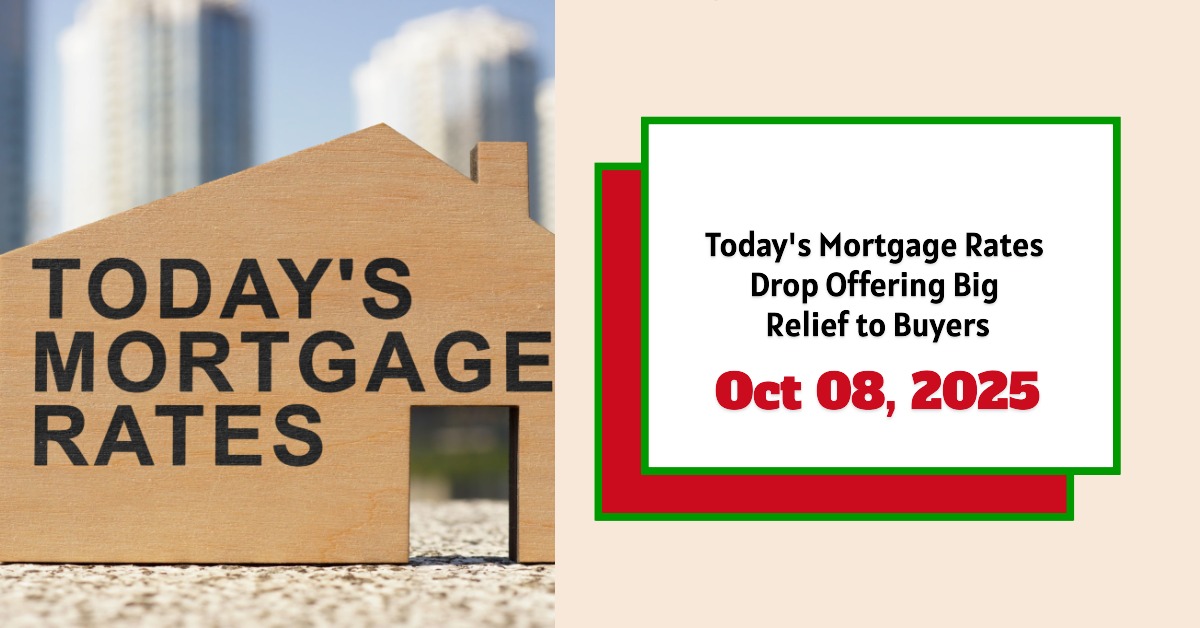As of October 8, 2025, the national average for a 30-year fixed mortgage has dipped to 6.42%. This is a welcome bit of news for anyone looking to buy a home or refinance an existing mortgage, as it represents a decrease from the previous week’s average. While this single number might seem small, changes in mortgage rates can have a significant impact on your monthly payments and the total cost of your loan over time.
For me, seeing these numbers isn't just about tracking statistics; it's about understanding the pulse of the housing market and how it affects real people's dreams of homeownership. This slight downward trend is a positive sign after a period of higher rates, suggesting that the market is beginning to stabilize and perhaps even offer a bit more breathing room for borrowers.
Today's Mortgage Rates – October 8, 2025: Rates Go Down Offering Relief to Buyers
Breaking Down Today's Mortgage Rates
Let's break down the specifics of what I'm seeing today, October 8, 2025, according to Zillow data.
- 30-Year Fixed-Rate Mortgages: The headline number is the 6.42% average. This is down 0.07% from the previous week, bringing it to 6.49% and down 10 basis points from 6.52% yesterday.
- 15-Year Fixed-Rate Mortgages: These are also seeing a nice dip, currently averaging 5.58%. This is down 0.09% from the previous week.
- 5-Year Adjustable-Rate Mortgages (ARMs): These are holding steady with a slight decrease, averaging 7.02%, down 0.02% from the previous week.
It’s important to remember that these are national averages. Your actual rate will depend on a variety of factors, including your credit score, down payment, loan type, and the lender you choose.
Comparing Loan Types: What's Shifting?
The data shows some interesting movements across different loan programs. It's not just the flagship 30-year fixed that's seeing changes. I always encourage my clients to look at the full picture.
Conforming Loans:
| Program | Rate | 1W Change | APR | 1W Change |
|---|---|---|---|---|
| 30-Year Fixed Rate | 6.42% | down 0.07% | 7.03% | up 0.10% |
| 20-Year Fixed Rate | 6.31% | down 0.04% | 6.81% | up 0.12% |
| 15-Year Fixed Rate | 5.58% | down 0.09% | 6.00% | up 0.04% |
| 5-Year ARM | 7.02% | down 0.02% | 7.81% | up 0.11% |
Government Loans:
| Program | Rate | 1W Change | APR | 1W Change |
|---|---|---|---|---|
| 30-Year Fixed FHA | 5.63% | down 0.13% | 6.63% | down 0.13% |
| 30-Year Fixed VA | 5.94% | down 0.08% | 6.06% | down 0.12% |
| 15-Year Fixed FHA | 5.25% | down 0.03% | 6.21% | down 0.03% |
| 15-Year Fixed VA | 5.74% | down 0.05% | 6.10% | down 0.04% |
Notice how the 30-year FHA loans saw a more significant rate decrease this week. This is often designed to make homeownership more accessible through government-backed programs. On the flip side, the APR for 30-year and 20-year fixed conforming loans have inched up slightly. The APR includes fees and other costs, so this is something to pay attention to when comparing offers. I always tell people to look at the APR as it gives a more complete picture of the loan's cost.
Refinance Rates: A Similar Trend
For those looking to refinance, the news is also largely positive, though the numbers are slightly different.
- 30-Year Fixed Refinance Rates: These have dropped to 6.84%, a significant decrease of 19 basis points from the previous week. This is a substantial improvement for homeowners looking to lower their monthly payments.
- 15-Year Fixed Refinance Rates: These are also down, now averaging 5.71%, a decrease of 13 basis points.
- 5-Year ARM Refinance Rates: These have seen a very slight increase to 7.54%.
Seeing refinance rates move lower is a strong indicator that lenders are becoming more competitive. If your current mortgage rate is higher than these numbers, it's definitely worth shopping around to see if you can save money. Locking in a lower rate can free up significant funds.
Understanding the “Why” Behind Today's Rates
It's easy to just look at the numbers, but understanding why they are moving is crucial for making informed decisions.
The Federal Reserve's Influence: We saw the Federal Reserve make its first interest rate cut of 2025 on September 17th, lowering the benchmark rate by a quarter percentage point. This was a big signal that the Fed is starting to ease borrowing costs. However, it's not as simple as the Fed cutting rates and mortgage rates immediately plummeting.
The Treasury Yield Connection: Mortgage rates, especially the 30-year fixed, are heavily influenced by the 10-year U.S. Treasury yield. Think of it as the benchmark. On October 1, 2025, the 10-year Treasury yield was around 4.12%, continuing a downward trend and sitting below its long-term average.
The Infamous “Spread”: Here’s where it gets a bit more complicated. Lenders don't just use the Treasury yield; they add a “spread” to cover their costs and risks. This spread is the difference between the Treasury yield and the mortgage rate. Lately, this spread has been wider than usual, sometimes over 2 percentage points. Even though Treasury yields have been falling, this wider spread has kept mortgage rates from dropping as much as they theoretically could. This is why mortgage rates haven't fallen as sharply as the Treasury yield might suggest.
Inflation as a Wildcard: The Fed's decision was a balancing act. While inflation is cooling, it's still above their 2% target (core PCE was 2.9% year-over-year in August). If inflation starts to creep back up, the Fed might slow down or even pause its rate cuts, which could put upward pressure on Treasury yields and, consequently, mortgage rates again.
Forecasting the Future: What Experts Are Saying
What does this all mean for the rest of 2025 and beyond? The forecasts offer some guidance, but remember, these are predictions, not guarantees.
- National Association of REALTORS®: They anticipate mortgage rates to average 6.4% in the latter half of 2025 and dip further to 6.1% in 2026. They see rates as a “magic bullet” for affordability.
- Fannie Mae: Their September 2025 forecast had rates ending 2025 at 6.4% and 2026 at 5.9%. They expect more refinance activity in 2026 as rates fall.
- Mortgage Bankers Association: They forecast a 30-year mortgage rate of 6.7% by the end of 2025, declining to 6.5% by the end of 2026. They note continued volatility and wider spreads will impact refinance opportunities.
These forecasts suggest a general trend towards lower rates, though the pace and extent of those declines can vary. The key takeaway from these expert opinions is that while we're seeing a positive trend, rates are unlikely to drop drastically overnight. Any significant drops will likely be tied to a narrowing of the mortgage-Treasury spread and sustained inflation cooling.
Related Topics:
Mortgage Rates Trends as of October 7, 2025
Mortgage Rates Predictions for the Next 12 Months: Oct 2025 to Oct 2026
Mortgage Rates Predictions for the Next 6 Months: October 2025 to March 2026
Mortgage Rates Predictions for Next 90 Days: October to December 2025
The Impact on Buyers and Sellers
- For Buyers: The current rates, while still higher than the historic lows of a few years ago, are more manageable. The decrease in rates specifically enhances affordability. However, the wide spread means the full benefit isn't always passed on, and in many markets, competition remains fierce. It’s more important than ever to get pre-approved and be ready to act when the right property comes along.
- For Sellers: A modest dip in rates could encourage some homeowners who have been “rate-locked” into their current mortgages to finally list their homes. This could lead to an increase in inventory on the market. However, if buyer demand rises faster than new listings, home price appreciation might continue.
My Personal Take: What I'm Watching
From my vantage point, the most critical factor to watch right now is that spread between Treasury yields and mortgage rates. If it continues to hover at these elevated levels, the relief for borrowers will be limited. However, as market uncertainty decreases and economic conditions stabilize, I anticipate this spread will normalize. This normalization, combined with the Fed's easing cycle, is what will pave the way for more significant declines, potentially pushing 30-year fixed rates below 6% sometime in 2026.
For anyone considering a home purchase or a refinance, my advice remains consistent: don't try to time the market perfectly. Focus on your financial goals, understand what you can comfortably afford, and lock in a rate when it makes sense for you. Today's numbers offer an attractive opportunity, especially for those looking to refinance.
Capitalize Amid Rising Mortgage Rates
With mortgage rates expected to remain high in 2025, it’s more important than ever to focus on strategic real estate investments that offer stability and passive income.
Norada delivers turnkey rental properties in resilient markets—helping you build steady cash flow and protect your wealth from borrowing cost volatility.
HOT NEW LISTINGS JUST ADDED!
Speak with a seasoned Norada investment counselor today (No Obligation):
(800) 611‑3060
Also Read:
- Will Mortgage Rates Go Down in 2025: Morgan Stanley's Forecast
- Mortgage Rate Predictions 2025 from 4 Leading Housing Experts
- Mortgage Rate Predictions for the Next 3 Years: 2026, 2027, 2028
- 30-Year Fixed Mortgage Rate Forecast for the Next 5 Years
- 15-Year Fixed Mortgage Rate Predictions for Next 5 Years: 2025-2029
- Will Mortgage Rates Ever Be 3% Again in the Future?
- Mortgage Rates Predictions for Next 2 Years
- Mortgage Rate Predictions for Next 5 Years
- Mortgage Rate Predictions: Why 2% and 3% Rates are Out of Reach
- How Lower Mortgage Rates Can Save You Thousands?
- How to Get a Low Mortgage Interest Rate?
- Will Mortgage Rates Ever Be 4% Again?



